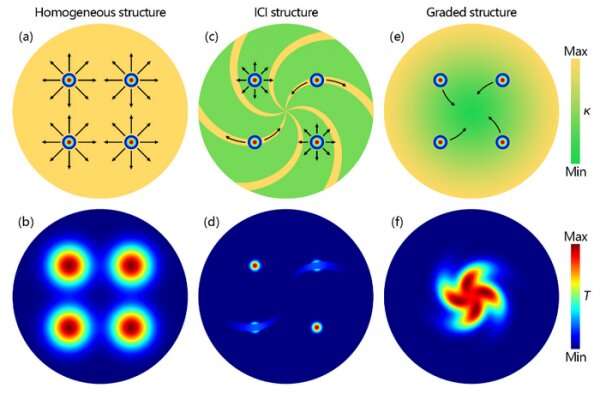Black hole-inspired thermal trapping with graded heat-conduction metadevices

Jiping Huang's group (Department of physics, Fudan University) and Cheng-Wei Qiu's group (Department of Electrical and Computer Engineering, National University of Singapore) collaborated to complete this study published in National Science Review. They found a new mechanism to generate asymmetric temperature profiles without dynamic modulation. Specifically, graded thermal conductivities could induce the imitated advection in pure and passive conduction, which has a similar temperature field effect to the realistic advection. With the imitated advection, heat could spontaneously converge to the center like black holes.
The teams experimentally demonstrated the imitated advection induced by graded thermal conductivities, a counterpart to graded refractive indexes responsible for the effective momentum in photonics. Thus, asymmetric temperature profiles could still be observed in opposite directions, though the system has no dynamic modulation. Moreover, the energy loss resulting from the natural convection and thermal radiation in experiments could facilitate asymmetric heat fluxes in opposite directions.
The researchers further designed the imitated advection to point towards the center. Hence, surrounding hot spots could be trapped towards the center like black holes. The conformal transformation theory could explain the physical basis for linking graded parameters and curvilinear spacetime. Inspired by rotational black holes, they also performed a rotation transformation on graded parameters to demonstrate rotational thermal trapping.
Both simulations and experiments verified their designs. Specifically, they fabricated two samples to demonstrate normal and rotational thermal trapping. Three common materials (i.e., copper, iron, and steel) increased the thermal conductivity gradient. These two samples were put into an ice water bath as a cold source for measurement. Heat guns generated hot spots, which could output a constant initial temperature. Then, the two types of thermal trapping were observed.
Thermal advection is crucial for non-Hermitian and nonreciprocal physics. Since the imitated advection has almost the same temperature field effect as the realistic advection, it is promising to reveal non-Hermitian and nonreciprocal phenomena with graded heat-conduction metadevices.
Moreover, due to the asymmetric thermal diffusion induced by the imitated advection, graded heat-conduction metadevices have potential applications for waste heat recovery and thermal funneling. A significant advantage is zero energy consumption because external drives are not required. These results could also bring new thoughts and perspectives linking diffusion systems (e.g., thermotics and particle dynamics), wave systems (e.g., photonics and acoustics), and cosmology systems (e.g., blackholes and wormholes).
More information: Liujun Xu et al, Blackhole-inspired thermal trapping with graded heat-conduction metadevices, National Science Review (2022). DOI: 10.1093/nsr/nwac159
Provided by Science China Press




















